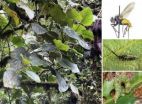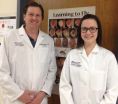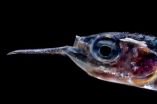(Press-News.org) The lipid-rich membranes of cells are largely impermeable to proteins, but evolution has provided a way through – in the form of transmembrane tunnels. A new study shows in unmatched detail what happens as proteins pass through such a pore.
Every cell is surrounded by a surface membrane and contains internal compartments bounded by membranes. Almost one-third of all proteins synthesized in cells must pass through these membranes or be incorporated into them in order to fulfil their functions. However, the fat-rich nature of membranes makes it impossible for most proteins to percolate through them directly. Therefore, biological membranes contain so-called protein-conducting channels, molecular pores through which proteins can pass. "Structural investigations have already provided clues to how proteins are inserted into the membrane and then drawn through it like a length of thread to emerge on the other side," says Professor Roland Beckmann of the Gene Center of Ludwig-Maximilians-Universitaet (LMU) in Munich. "However, conclusive proof for these mechanisms has been lacking until now."
Protein-conducting channels are known to be shaped like an hour-glass, consisting of two cones connected by a narrow central constriction. In the inactive form, the constriction is blocked by a plug that protrudes from the side-wall. Presumably, if a protein is to cross the membrane, the channel must be opened to provide a continuous aqueous environment for its passage. If, on the other hand, a protein is to be inserted within the membrane itself, it must emerge from a lateral opening within the tunnel.
Imaging the crucial transition
"Up until now, it had not been possible to characterize these structural transitions with the required spatial and temporal resolution," Beckmann says. Now he and his colleagues have, for the first time, succeeded in isolating transitional forms of the active channel, and elucidating their three-dimensional structures with the help of cryo-electron microscopy – at the unprecedented resolution of less than 1 nanometer. "This allowed us to determine the spatial conformations of the individual protein strands that make up the channel and to analyze how the channel behaves during its functional cycle," he explains.
Indeed, the researchers were even able to capture a snapshot of the complex at the moment when a protein leaves the channel to be incorporated into the cell membrane. "It turns out that there actually is a side-door within the channel, which opens to allow the protein to diffuse into the membrane," Beckmann says. Interestingly, as the lateral gate opens and the protein exits the channel into the membrane, the plug moves into the central constriction, blocking access to the outside and preventing diffusion of ions through the now empty channel. Surprisingly, proteins destined to cross the membrane do so without altering the position of the plug very much. Instead, an adjacent strand shifts slightly outward, widening the constriction sufficiently to let the protein through the length of the tunnel.
Beckmann and his team now hope to be able to increase the resolution of their snapshots still further. "Our goal is to achieve a resolution of less than 0.4 nm, in order to discern the interactions in molecular detail and understand the dynamic changes that take place in the structure of the channel," he says. In addition, the scientists want to image other membrane protein complexes – such as visual pigments – and analyze how a single chain of amino acids can function as a dynamically active membrane receptor.
INFORMATION: END
Protein structure: Peering into the transit pore
2014-02-07
ELSE PRESS RELEASES FROM THIS DATE:
Beta blockers and perioperative care: EHJ editorial addresses controversy
2014-02-07
Zurich, 7 February 2014. Since the end of 2011 when the scientific work of Professor Don Poldermans was first scrutinized there has been controversy in the medical world about the use of beta blockers in perioperative care.
The recent publication - and retraction for proper peer reviewing and revision - in the European Heart Journal (EHJ) of a paper by Professors Cole and Francis from Imperial College, questioning whether beta blockers in perioperative care could lead to a mortality increase brought the topic back into the public eye.
The EHJ has published an editorial ...
The biomass of ocean mesopelagic fish is 10 times higher than estimated
2014-02-07
The total stock of fish on the planet had been reckoned until today to be around 2,000 million tonnes. About half of them were thought to be mesopelagic fish, in other words, ones found at depths of between 200 and 1,000 metres in ocean areas.
However, an international team*, in which AZTI-Tecnalia researchers are participating and which is being led by the doctor in oceanography Xabier Irigoien, has discovered that its abundance could be at least 10 times higher than the original estimate. The results have been published in the journal Nature Communications.
Mesopelagic ...
New plant species a microcosm of biodiversity
2014-02-07
Biologists working in the Andes mountains of Ecuador have described a new plant species, a wild relative of black pepper, that is in itself a mini biodiversity hotspot. The new species, Piper kelleyi, is the sole home of an estimated 40-50 insect species, most of which are entirely dependent on this plant species for survival. This discovery is part of a larger project which focuses on the influence of plant-produced chemical compounds on biodiversity. The study was published in the open access journal PhytoKeys.
The chemical compounds produced by plants are source of ...
Avian flu variant stalks Egypt
2014-02-07
Since its first identification in Asia, highly pathogenic avian influenza—H5N1—has caused significant alarm in the scientific community. While the virus' primary target is birds—tens of millions have already died from it—it is capable of infecting mammals, including humans, causing serious illness and a frightening rate of mortality.
In a new study, Matthew Scotch, a researcher at Arizona State University's Biodesign Institute, tracks the spread of an H5N1 variant in Egypt—a country recently identified as a major epicenter for the virus. In results recently appearing ...
Substance in photosynthesis was at work in ancient, methane-producing microbes
2014-02-07
An international team of researchers led by scientists at Virginia Tech and the University of California, Berkeley has discovered that a process that turns on photosynthesis in plants likely developed on Earth in ancient microbes 2.5 billion years ago, long before oxygen became available.
The research offers new perspective on evolutionary biology, microbiology, and the production of natural gas, and may shed light on climate change, agriculture, and human health.
"By looking at this one mechanism that was not previously studied, we will be able to develop new basic ...
Finding could explain age-related decline in motor function
2014-02-07
SAN ANTONIO (Feb. 6, 2014) — Scientists from the School of Medicine at The University of Texas Health Science Center at San Antonio have found a clue as to why muscles weaken with age. In a study published Feb. 5 in The Journal of Neuroscience, they report the first evidence that "set points" in the nervous system are not inalterably determined during development but instead can be reset with age. They observed a change in set point that resulted in significantly diminished motor function in aging fruit flies.
"The body has a set point for temperature (98.6 degrees), ...
Gender influences symptoms of genetic disorder
2014-02-07
A genetic disorder that affects about 1 in every 2,500 births can cause a bewildering array of clinical problems, including brain tumors, impaired vision, learning disabilities, behavioral problems, heart defects and bone deformities. The symptoms and their severity vary among patients affected by this condition, known as neurofibromatosis type 1 (NF1).
Now, researchers at Washington University School of Medicine in St. Louis have identified a patient's gender as a clear and simple guidepost to help health-care providers anticipate some of the effects of NF1. The scientists ...
The fatality rate among hard drug users is 14 times higher than for the general population
2014-02-07
A new study analyses the risk factors and excess mortality among heroin and cocaine consumers admitted to treatment in Spain. The results reveal that the fatality rate among consumers of both drugs is 14.3 times higher than for the general population, while among those only using cocaine, it is 5.1 times higher.
In Spain the majority of deaths related to cocaine are not correctly certified and therefore up until now very few studies have been carried out that analyse the consequences of consuming these drugs in terms of mortality.
"Death certificates rarely include ...
Smithsonian reports GMO soybean pollen threatens Mexican honey sales
2014-02-07
Mexico is the fourth largest honey producer and fifth largest honey exporter in the world. A Smithsonian researcher and colleagues helped rural farmers in Mexico to quantify the genetically modified organism (GMO) soybean pollen in honey samples rejected for sale in Germany. Their results will appear Feb. 7 in the online journal, Scientific Reports.
David Roubik, senior staff scientist at the Smithsonian Tropical Research Institute, and colleagues developed the ability to identify pollen grains in honey in Panama and in Mexico during the 1980s and 1990s when they studied ...
Fish biomass in the ocean is 10 times higher than estimated
2014-02-07
With a stock estimated at 1,000 million tons so far, mesopelagic fish dominate the total biomass of fish in the ocean. However, a team of researchers with the participation of the Spanish National Research Council (CSIC) has found that their abundance could be at least 10 times higher. The results, published in Nature Communications journal, are based on the acoustic observations conducted during the circumnavigation of the Malaspina Expedition.
Mesopelagic fishes, such as lantern fishes (Myctophidae) and cyclothonids (Gonostomatidae), live in the twilight zone of the ...




